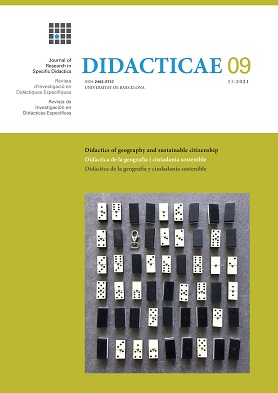Proyecto de innovación docente en geografía y educación ambiental para estudiantes con trastorno del espectro autista
Teaching innovation project in geography and environmental education for students with autist spectrum disorder
DOI:
https://doi.org/10.1344/did.2021.9.84-99Keywords:
geography, environmental education, students with special educational needs, autism spectrum disorder, ICT, ScratchAbstract
In this paper, the design of an Environmental Education program is proposed for students with Autism Spectrum Disorder (ASD) through activities to be carried out with Scratch and taught thanks to Information and Communication Technologies (ICT). The main objective is to design and create multimedia materials to improve the teaching-learning process of students with ASD and contribute to their training to understand the current problems in relation to the environment so they can act responsibly and respect and care for nature. This teaching innovation project is organized in four main sections (initial approach, theoretical framework, methodology and design) that correspond to the phases followed to design the material. The results of surveys aimed at evaluating knowledge, interests and attitudes about environmental problems have served to design and develop a didactic resource adjusted to the socio-environmental reality, contextualizing it in a special education school in Ciudad Real, which can be extrapolated to any educational school. The situation that has caused the state of health alarm in Spain, together with the interest of students with ASD in electronic devices and ICTs, has motivated the planning of this educational intervention proposal resolved with the design of teaching materials for this context.References
Alcantud Marín, F. (2000). Nuevas tecnologías, viejas esperanzas: las nuevas tecnologías en el ámbito de la discapacidad y las necesidades educativas especiales. Murcia: Consejería de Educación.
American Psychiatric Association (APA) (1994). Diagnostic and statiscal manual of mental disorders. Fourth edition. DSMMD-IV (pp. 65-78). Washington, DC: American Psychiatric Association.
American Psychiatric Association (APA) (2013). Manual diagnóstico y estadístico de los trastornos mentales (DSM-5) (Quinta edición). Madrid: Editorial Médica Panamericana
Artigas-Pallarés, J., y Paula, I. (2012). El autismo 70 años después de Leo Kanner y Hans Asperger. Revista Asociación Española de Neuropsiquiatría, 32(115), 567-587.
Asperger, H. (1991). Autistic psychopathy in childhood (U. Frith, Trans- Annot.). En U. Frith (Ed.), Autism and Asperger Syndrome (pp. 37-92). New York: Cambridge University Press (Publicado originalmente en 1944).
Baron-Cohen, S. (1993). From attention-goal psychology to belief-desire psychology: The development of a theory of mind, and its dysfunction. En S. Baron-Cohen, H. Tager- Flusberg y D.Cohen (Eds.), Understanding other minds: Perspectives from autism (pp. 59-82). Oxford University Press.
Belloch Ortí, C. (2009). Evaluación de aplicaciones multimedia: criterios de calidad. Valencia: Universidad de Valencia. Unidad de Tecnología Educativa.
Bettelheim, B. (1967). The empty fortress: infantile autism and the birth of self. New York: The Free Press.
Cuesta, J. L., y Abella, V. (2012). Tecnologías de la Información y la Comunicación: aplicaciones en el ámbito de los Trastornos del Espectro Autista. Siglo Cero: Revista Española sobre discapacidad intelectual, 43(2), nº 242, 6-25.
Dick, W., y Carey, L. (2004) (6ª. edición). The systematic design of instruction. Boston: Pearson, Allyn y Bacon.
Gallego Matellán, M. (2012). Guía para la integración del alumnado con TEA en Educación Primaria. Salamanca: Instituto Universitario de Integración en la comunidad. Universidad de Salamanca.
Kanner, L. (1943). Autistic disturbances of affective contact. Nervous Child, 2, 217–250.
Murga-Menoyo, Mª A., y Bautista-Cerro, Mª J. (Ed.) (2019). Guía PRADO. Sostenibilizar el currículo de la Educación Secundaria. Madrid: UNED.
Novo, M. (2003). La educación ambiental. Bases éticas, conceptuales y metodológicas. Madrid: Editorial Universitas, S.A.
Papert, S. (1980). Mindstorms: children, computers, and powerful Ideas. New York: BasicBooks.
Pérez de la Maza, L. (2000). Aplicaciones informáticas para alumnos/as con Trastornos del Espectro Autista. X Congreso Nacional de Autismo de AETAPI “Abriendo Puertas”. Vigo, 23, 24 y 25 Noviembre. Recuperado de: http://aetapi.org/x-congreso-nacional-de-autismo/
Tortosa Nicolás, F. (2002). Avanzando en el uso de la TIC con personas con trastorno del espectro autista: usos y aplicaciones educativas. En F. J. Soto y J. Rodríguez (Coords.), Las nuevas tecnologías en la respuesta educativa a la diversidad. Murcia: Consejería de Educación.
Wing, L., y Attwood, A. (1988). Syndromes of autism and atypical development. En D. Cohen, y A. Donnellan (Eds.), Handbook of autism and pervasive disorders. New York: John Wiley & Sons.
Vídeos
Resnick, M. (2012). Let's teach kids to code (subtitulado en español) [Archivo de vídeo]. Recuperado de http://www.ted.com/talks/mitch_resnick_let_s_teach_kids_to_code#. (Consultado el 2 de abril de 2020)
Legislación
Ley 14/1970, de 4 de agosto, General de Educación y Financiamiento de la Reforma Educativa. Madrid: Boletín Oficial del Estado (LGE).
Ley 13/1982, de 7 de abril, de integración social de los minusválidos. Madrid: Boletín Oficial del Estado (LISMI).
Ley Orgánica 1/1990, de 3 de octubre, de Ordenación General del Sistema Educativo. Madrid: Boletín Oficial del Estado (LOGSE).
Ley Orgánica 2/2006, de 3 de mayo, de Educación. Madrid: Boletín Oficial del Estado (LOE).
Ley Orgánica 8/2013, de 9 de diciembre, para la mejora de la calidad educativa. Madrid: Boletín Oficial del Estado (LOMCE).
Downloads
Published
Issue
Section
License
Copyright (c) 2021 Óscar Jerez García, Claudia Vera Díaz

This work is licensed under a Creative Commons Attribution-ShareAlike 4.0 International License.
The authors who publish in this journal agree to the following terms:
- Authors retain copyright and grant the journal the right of first publication.
- Submitting a paper does not involve paying any fees.
- Texts will be published under a Creative Commons Attribution Share-Alike 4.0 International License that allows others to share the work, provided they include an acknowledgement of the work’s authorship, its initial publication in this journal and the terms of the license.
- When citing works published in Didacticae, both the autor and the journal must be cited.
- Didacticae does not accept any responsibility for the points of view and statements made by the authors.



